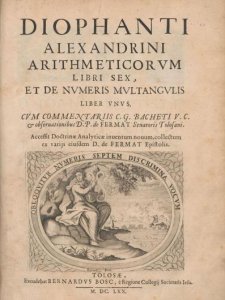A diophantine equation is an algebraic equation, or system of equations, in several unknowns and with integer (or rational) coefficients, which one seeks to solve in integers (or rational numbers). The study of such equations goes back to antiquity. Their name derives from the mathematician Diophantus of Alexandria, who wrote a treatise on the subject, entitled Arithmetica.
The most famous example of a diophantine equation appears in Fermat’s Last Theorem. This is the statement, asserted by Fermat in 1637 without proof, that the diophantine equation has no solutions in whole numbers when n is at least 3, other than the 'trivial solutions' which arise when XYZ = 0. The study of this equation stimulated many developments in number theory. A proof of the theorem was finally given by Andrew Wiles in 1995.
The basic question one would like to answer is: does a given system of equations have solutions? And if it does have solutions, how can we find or describe them? While the Fermat equation has no (non-trivial) solutions, similar equations (for example ) do have non-trivial solutions. One of the problems on Hilbert’s famous list from 1900 was to give an algorithm to decide whether a given system of diophantine equations has a solution in whole numbers. In effect this is asking whether the solvability can be checked by a computer programme. Work of Martin Davis, Yuri Matiyasevich, Hilary Putnam and Julia Robinson, culminating in 1970, showed that there is no such algorithm. It is still unknown whether the corresponding problem for rational solutions is decidable, even for plane cubic curves. This last problem is connected with one of the Millennium Problems of the Clay Mathematics Institute (with a million dollar prize): the Birch Swinnerton Dyer Conjecture.
To find out more about diophantine problems read Professor Jonathan Pila's latest addition to our Oxford Mathematics Alphabet.


